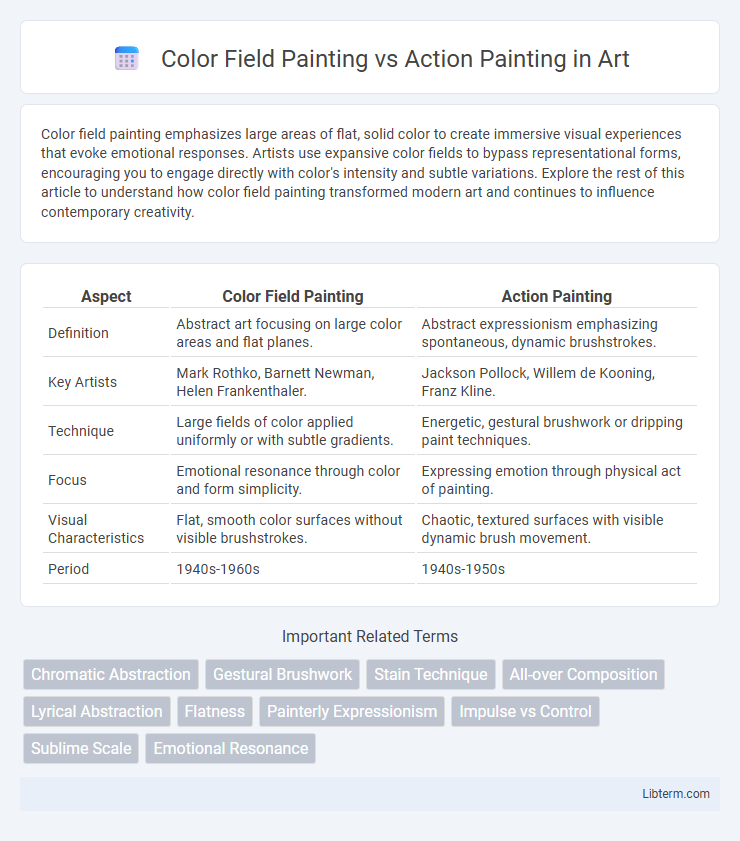Color field painting emphasizes large areas of flat, solid color to create immersive visual experiences that evoke emotional responses. Artists use expansive color fields to bypass representational forms, encouraging you to engage directly with color's intensity and subtle variations. Explore the rest of this article to understand how color field painting transformed modern art and continues to influence contemporary creativity.
Table of Comparison
| Aspect | Color Field Painting | Action Painting |
|---|---|---|
| Definition | Abstract art focusing on large color areas and flat planes. | Abstract expressionism emphasizing spontaneous, dynamic brushstrokes. |
| Key Artists | Mark Rothko, Barnett Newman, Helen Frankenthaler. | Jackson Pollock, Willem de Kooning, Franz Kline. |
| Technique | Large fields of color applied uniformly or with subtle gradients. | Energetic, gestural brushwork or dripping paint techniques. |
| Focus | Emotional resonance through color and form simplicity. | Expressing emotion through physical act of painting. |
| Visual Characteristics | Flat, smooth color surfaces without visible brushstrokes. | Chaotic, textured surfaces with visible dynamic brush movement. |
| Period | 1940s-1960s | 1940s-1950s |
Introduction to Abstract Expressionism
Abstract Expressionism emerged in the mid-20th century as a revolutionary art movement characterized by two primary styles: Color Field Painting and Action Painting. Color Field Painting emphasizes large expanses of flat, solid color to evoke emotional responses through simplicity and chromatic intensity, exemplified by artists like Mark Rothko and Barnett Newman. In contrast, Action Painting centers on dynamic, spontaneous brushwork and physical movement, with Jackson Pollock and Willem de Kooning pioneering this energetic approach to abstract creation.
Defining Color Field Painting
Color Field Painting emphasizes large expanses of uniform color, creating an immersive visual experience that evokes emotion through simplicity and color harmony. This style, pioneered by artists like Mark Rothko and Barnett Newman, contrasts with Action Painting by focusing on calm, static compositions rather than dynamic brushstrokes. The movement highlights the flatness of the canvas, using color as both subject and form to engage viewers in contemplative observation.
Understanding Action Painting
Action Painting emphasizes dynamic brushstrokes, vigorous movement, and the physical act of painting as a central element, contrasting with Color Field Painting's focus on large, solid areas of color and visual flatness. This approach highlights spontaneity and emotional intensity through dripping, splattering, and gestural marks, exemplified by artists like Jackson Pollock. Understanding Action Painting involves recognizing the canvas as an arena for energetic expression rather than a mere surface for color arrangement.
Historical Origins and Influences
Color Field Painting originated in the 1940s and 1950s as part of the Abstract Expressionist movement, heavily influenced by artists like Mark Rothko and Barnett Newman who emphasized large, solid blocks of color to evoke emotional responses. Action Painting, pioneered by Jackson Pollock and Willem de Kooning, emerged simultaneously with a focus on spontaneous, dynamic brushstrokes and the physical act of painting as an expression of the subconscious. Both styles reflect post-World War II American art's shift towards exploring emotion and individual expression, diverging from traditional representational forms.
Key Artists and Pioneers
Color Field Painting, characterized by large expanses of color and subtle tonal variations, was pioneered by artists like Mark Rothko, Barnett Newman, and Helen Frankenthaler, who emphasized emotional resonance through color and simplicity. In contrast, Action Painting focused on dynamic, gestural brushstrokes and the physical act of painting itself, with Jackson Pollock, Willem de Kooning, and Franz Kline as central figures driving this movement. Both styles emerged from Abstract Expressionism but diverge in technique and artistic intention, with Color Field prioritizing color and form, while Action Painting emphasizes movement and spontaneity.
Techniques and Artistic Processes
Color Field Painting emphasizes large areas of flat, unbroken color applied with smooth brushwork or staining techniques, creating a meditative and immersive visual experience. Action Painting relies on energetic, gestural brushstrokes, drips, and splatters to express the artist's physical engagement and spontaneous process. While Color Field artists like Mark Rothko focus on color relationships and surface, Action Painters such as Jackson Pollock prioritize dynamic movement and the physical act of painting.
Aesthetic Principles and Visual Impact
Color Field Painting emphasizes large, uniform expanses of color that evoke emotional resonance through simplicity and spatial depth, creating a meditative visual impact. Action Painting relies on dynamic brushstrokes and gestural movements, conveying spontaneity and physical energy that engage viewers with immediate intensity. Both styles challenge traditional composition, but Color Field invites contemplation through color harmony, while Action Painting captures raw expressiveness and movement.
Emotional Expression and Viewer Experience
Color Field Painting emphasizes vast areas of solid color to evoke contemplative, meditative emotional responses, allowing viewers to immerse themselves in pure color and experience calm or introspective feelings. In contrast, Action Painting captures dynamic gestures and energetic brushstrokes that convey intense emotion and spontaneity, engaging viewers with the artist's physical movement and emotional intensity. Both styles use abstract elements to evoke emotions, but Color Field Painting offers a serene, immersive experience while Action Painting delivers a visceral, energetic connection.
Notable Works in Each Movement
Color Field Painting is exemplified by Mark Rothko's "No. 61 (Rust and Blue)" and Barnett Newman's "Vir Heroicus Sublimis," which emphasize expansive fields of flat, solid color to evoke emotional resonance. Action Painting showcases Jackson Pollock's "No. 5, 1948" and Willem de Kooning's "Woman I," characterized by dynamic brushstrokes and energetic drips that capture the artist's movement and spontaneity. These notable works highlight the contrast between the meditative calm of Color Field and the intense expressiveness of Action Painting.
Lasting Legacy and Contemporary Relevance
Color Field Painting's lasting legacy lies in its influence on minimalism and large-scale abstract art, characterized by expansive color areas promoting meditative visual experiences. Action Painting revolutionized contemporary art through its emphasis on dynamic brushwork and spontaneous creation, impacting performance art and abstract expressionism. Both movements continue to resonate by inspiring diverse artistic practices that explore emotion, process, and the physicality of paint.
Color Field Painting Infographic

 libterm.com
libterm.com